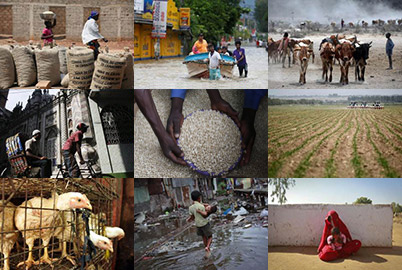Max Beauvoir features in One Day in Port-au-Prince, a multimedia documentary.
PORT-AU-PRINCE (AlertNet) - It’s a dangerous time to be a Voodoo priest in Haiti.
Since a cholera epidemic started in mid-October, at least 45 Voodoo priests have been hacked to death by lynch mobs, accused of casting spells to spread the disease, according to Max Beauvoir, the supreme leader of Haitian Voodoo.
How different things were in early October when I visited Beauvoir’s temple on the outskirts of Port-au-Prince, an oasis of exotic carvings and esoteric symbols amid tropical trees he planted himself.
At the time, the absence of any major disease outbreak following the Jan. 12 earthquake felt like the great unsung victory of an international relief effort thin on victories.
And Voodoo, a religion that more than half of Haiti’s nearly 10 million people are believed to practice, was coexisting pretty peacefully with Christianity. About 80 percent of Haitians are also Catholic, which means a lot of people practise both religions without seeing much problem.
“Voodoo is the tradition of the Haitian people,” Beauvoir said, sitting in a meeting hall adorned with photos of foreign and local dignitaries visiting the temple. “We say it is for us like our flesh and blood.”
The religion mixes elements of Catholicism with traditional beliefs brought from West Africa several centuries ago by slaves forced to work on the plantations of what was then the French colony of Saint Domingue.
Recognised and protected by Haiti’s constitution, Voodoo had an especially high profile in the weeks following the quake as its priests took a stand against the anonymous mass burials of tens of thousands of victims.
Such burials without proper rights were seen as a desecration in a country where many believe in zombies – dead bodies brought back to life by supernatural forces.
Beauvoir, 76, led the protests. And in late March, he presided over a ceremony in a public square in the capital with several hundred Voodoo practitioners to honour those killed.
“They grabbed them with those big teeth, you know those cranes, and they just came and grabbed people together and simply dropped them in the holes,” he said of the mass burials. “I think it was undignified, and I screamed… I said you cannot do that because we have beliefs. And in our beliefs, the body is sacred.”
Beauvoir was a Western-educated biochemist and anthropologist before becoming, in 2008, the first supreme leader (or “Ati”) of a religion that had never had much formal structure in Haiti.
His soft-spoken eloquence in Creole, English and French has made him an effective ambassador for Voodoo, both at home and abroad.
That’s particularly true when it comes to challenging what he described as pins-in-dolls Hollywood myths and scare-mongering by Christian missionaries keen to equate Voodoo with devil worship.
“I think there has been a war waged against the Haitian people, below the table,” he said. “Haitians have been prevented from moving forward. In fact, some children have been taken and so to speak converted to look at their fathers and mothers who give them food and schooling and everything else, to see them as enemies, to see them as devilish or satanic simply because a crazy professor has told them that.”
Since the quake, Voodoo priests have had to defend themselves publically against accusations by some Evangelical preachers that the religion somehow caused the disaster.
One such claim came from influential U.S. televangelist Pat Robertson just a day after the catastrophe killed more than 250,000 people. Robertson said on his TV show that Haiti had been “cursed” ever since it swore a “pact to the devil” when it achieved independence from France in 1804.
“That was really mean,” Beauvoir said. “It was the moment where nationally we needed more compassion and more help, and look what he said… But you get people like that.”
A few days after our interview, Beauvoir invited us back to his temple, the Peristyle de Mariani, to watch an initiation ceremony for two new priests, or houngans.
In flowing white, about a dozen dancers twirled to a frenzied drumbeat, chanting and spinning around a totem pole. As darkness fell and firelight flickered, one woman held up a squawking chicken. She plucked its feathers before severing its neck and splashing the dirt with blood.
Beauvoir sat to one side, watching the ceremony with bright, penetrating eyes. Occasionally, he’d join the dancers, shaking a gourde rattle and saying sacred words to the initiates who wore stained headscarves pulled down over their eyes.
Earlier, he had elaborated on the beliefs he said had brought comfort to many Haitians following the earthquake - beliefs blending familiar facets of Christianity such as a single God with animist and supernatural elements.
“This is how we view ourselves in the universe, where we stand among the sun, the moon and the stars and the earth and everything that exists, with the trees and the plants and the animals: we are part of the whole thing. We build a relationship with all of them.
"We have our own ideas about creation," he continued. "It certainly doesn’t resemble the idea of Adam and Eve – Eve swallowing a bad apple, giving a bad apple to her husband and having to pay. That isn’t part of our mythology.”

